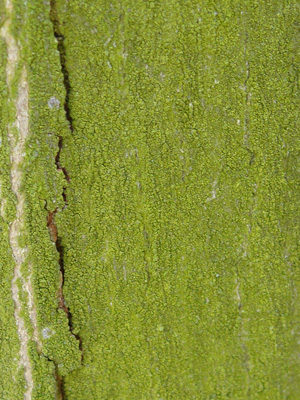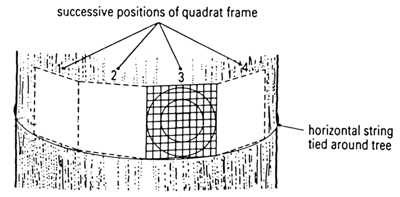Observing patterns in the distribution of a simple plant
Class practical
Pleurococcus is a wide-spread alga whose distribution depends on exposure to light, wind and water. It is a chlorophyte and is usually considered to be part of the kingdom Plantae – so it is acceptable to refer to it as a simple plant. Here, you can use a small quadrat to measure the distribution of an organism and relate that distribution to readily identifiable environmental factors.
Lesson organisation
This protocol depends on students' understanding the use of quadrats for sampling, and the environmental factors that influence the growth of plants. As described in the teaching notes, you may wish to discuss accuracy and precision, and define the degree of accuracy required for this protocol. Then, in the lab, develop students’ skills in the use of these quadrats to quickly establish percentage cover before going outside. With this emphasis on general scientific method as well as on the assessment of the Pleurococcus population, this procedure could take one lesson for preparation, and another for data collection and analysis.
Apparatus and Chemicals
For each group of students:
Compass or marker on the ground showing direction of N, S, E and W
Clipboard
Quadrat – 10 cm x 10 cm of 1 cm grid squares photocopied onto acetate (as thick as is available for copying onto)
Graph paper
Paper
Pencil
String, long enough to fasten around a tree (1.5–2 m), marked or knotted at 10 cm intervals
Health & Safety and Technical notes
Make an appropriate risk assessment before working outside. On return, observe good hygiene practice on returning to the building.

1 This procedure depends on students being able to identify Pleurococcus accurately. There is a photograph available here that is copyright free for all purposes.
2 Refer to CLEAPSS handbook section 17 for more information on planning safe outdoor activities, and to CLEAPSS supplementary risk assessment Practical activities in the school grounds (SRA 08, October 2006). Some elements of these ideas are listed in the safety notes for Biodiversity in your backyard on this site.
You should also refer to your Local Authority or employer’s guidelines for working outside the classroom in planning these activities.
Procedure
SAFETY:
Make a risk assessment of the outside area where the students will be working (Note 2). Consider trip and slip hazards, specific hygiene issues (for example, excreta left by dogs or other animals), and hazards from sharp materials in the area.
Preparation
a Locate some trees with populations of Pleurococcus on their bark, in an area you have assessed as low hazard or for which you can put suitable risk control measures in place.
b Establish the direction of magnetic North, and, if possible, of the prevailing winds.
c Make copies of acetate quadrats and cut string to length.
Investigation
d Ask the students to look at the trunks of trees in your school grounds or in their gardens at home. Look for evidence of green, powdery growth on the trunk (see photograph). This is a cluster of tiny single-celled plants called Pleurococcus.
e Draw how the base of the tree trunk looks from the north and the south. Show where the Pleurococcus is growing by shading on the drawing. If the green patches are more dense in some areas than others, shade those areas darker on the drawing.
f Take a piece of string marked at 10 cm intervals. Fix it around the trunk of the tree about 1–1.5 m above the ground (above dog height!).
g Place a 10 cm x 10 cm quadrat on the string at one point. Estimate the density of Pleurococcus by estimating the percentage of bark under the quadrat that is covered in the alga.

h Move the quadrat along as shown in this diagram, and repeat the estimation.
i Display the results as a bar chart of percentage cover against aspect. Aspect means the direction (N, S, E or W) that the patch of tree trunk faces.
Teaching notes
It’s worth spending some time practising with the 10 cm x 10 cm quadrat before working on the trees. Make estimates of percentage cover in the lab, using grids with a known number of squares coloured/ shaded.
This is an opportunity to discuss the difference between accuracy and precision, and to evaluate which is more important in this kind of investigation. In this practical, it is useful for students to develop the confidence to make quick assessments of each quadrat so that the work does not become tedious. An accuracy of ± 5% or even ±10% will give useful results. Precise measurements (± 1%) will take more time and effort to make. In this case, you will be looking for a pattern with large variations in percentage cover on different aspects of the tree, rather than small variations.
Discuss the results of the procedure and relate the pattern of growth of Pleurococcus to what is known about the conditions needed for photosynthesis. Does this alga grow best in the strongest light? Where does it get water from? Is it influenced by exposure to strong winds? Strong winds might dry out the bark more quickly, but such a small plant would not be buffeted by them. Strong sunlight will also dry the bark more quickly, so perhaps the greatest growth will be on the north side of the trees. Although the light intensity is less, there is enough light for these algae to grow.
Health & Safety checked, September 2009
Downloads
Download the student sheet ![]() Observing patterns in the distribution of a simple plant (205 KB) with questions and answers.
Observing patterns in the distribution of a simple plant (205 KB) with questions and answers.


